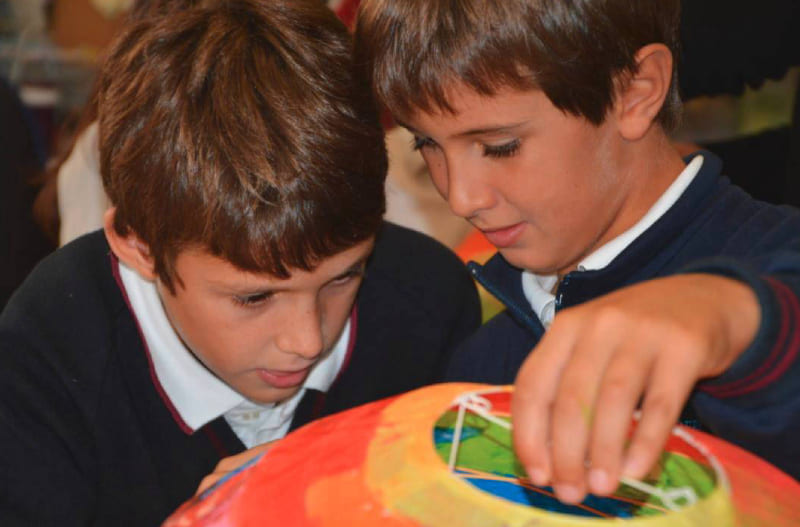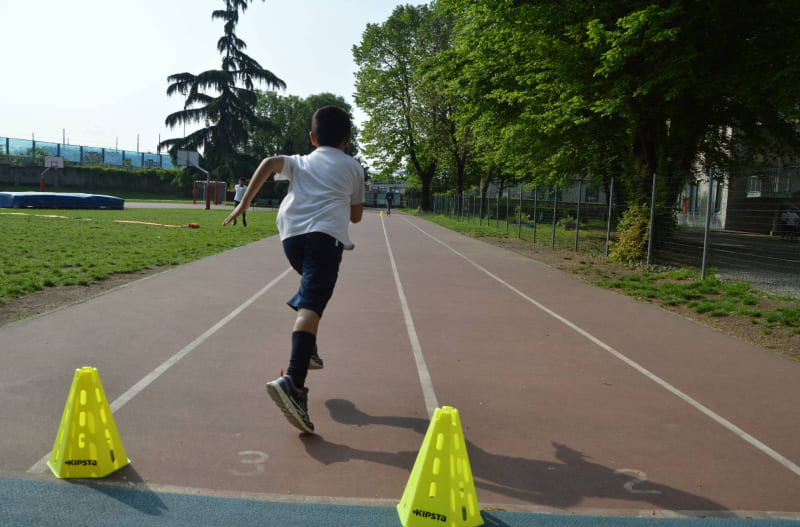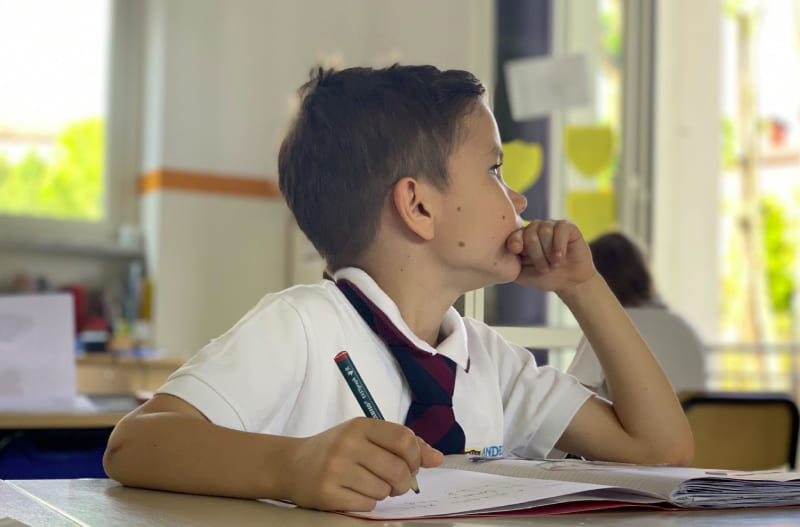Home » Early Years: Foundation Stage
Early Years: Foundation Stage
Children up to five years follow the Early Years Foundation Stage Profile, working towards the Early Learning Goals in the seven areas of learning.
Early Years is divided up into three classes:
- Nursery (starting from 24 months)
- Kindergarten: 3 years old
- Reception: 4 years old

At our school, we recognise that every child is a competent learner, who can be resilient, capable, confident and self assured. Children’s attitudes and dispositions to learning are influenced by feedback from others. We use praise and encouragement daily in the classroom as well as a ‘star of the week’ assembly once a week.
We value the diversity of individuals within the school and do not discriminate against children because of ‘differences’.
It is important to us that all children in the school are ‘safe’. We aim to educate children on boundaries, rules and limits and to help them understand why they exist.
At Andersen School we recognise that children learn to be strong independent from secure relationships.
We recognise that parents are children’s first and most enduring educators and we value the contribution they make.
Timetable
1
Sample
Lorem ipsum dolor sit amet, consectetur adipiscing elit. Ut elit tellus, luctus nec ullamcorper mattis, pulvinar dapibus leo.
2
Sample
Lorem ipsum dolor sit amet, consectetur adipiscing elit. Ut elit tellus, luctus nec ullamcorper mattis, pulvinar dapibus leo.
3
Sample
Lorem ipsum dolor sit amet, consectetur adipiscing elit. Ut elit tellus, luctus nec ullamcorper mattis, pulvinar dapibus leo.
4
Sample
Lorem ipsum dolor sit amet, consectetur adipiscing elit. Ut elit tellus, luctus nec ullamcorper mattis, pulvinar dapibus leo.
5
Sample
Lorem ipsum dolor sit amet, consectetur adipiscing elit. Ut elit tellus, luctus nec ullamcorper mattis, pulvinar dapibus leo.

We do this through:
- Giving the children the opportunity to spend 1 hour morning sessions at the beginning of the first term in Nursery and Kindergarten
- Inviting all parents to an induction meeting during the first term of school
- Operating an open door policy for parents with any queries
- Having ‘open lessons’ throughout the year, in which parents can come and take part in an actual lesson
- Inviting parents in during Global
- Speaking in English Week, Book Month and when talking about families
- Meeting formally with parents in the autumn, spring and summer terms at which the teacher and the parent discuss the child’s progress
- Giving parents a ‘Progress Check’ when a child reaches the age of 2
- Giving parents two reports on their child’s attainment and progress over the scholastic year
At Andersen School we recognise that the environment plays a key role in supporting and extending the children’s development. Through observation we identify the children’s achievements, interests and next steps for learning. These observations are then used to plan for the children’s interests.
The EYFS program consists of long, medium and short term planning which is based around class topics. These plans are used by the EYFS teacher as a guide for weekly planning; however the teacher may alter these in response to the needs (achievements and interests) of the children.
Assessment in the EYFS takes the form of formal and informal observations, and this involves the teacher and other adults as appropriate. Within the final term of the EYFS we provide a written summary to parents.
The Foundation Stage classroom is organised to allow children to explore and learn securely and safely. There are areas where the children can be active, be quiet and creative, can explore, use their senses and be physically active and exuberant.
DEVELOPMENT
This curriculum is divided into developmental stages: from birth to 11 months, from 8 to 20 months, from 16 to 26 months, from 30 to 50 months, and from 40 to 60 months. In general, stimuli for the planning of Nursery School children come from the 22-36 months section, from 30-50 months for Kindergarten, and from 40-60 months for Reception. This will be differentiated appropriately by working from the lower or higher developmental stages.
PLAY
Through play, our children explore and develop learning experiences that help them make sense of the world. They have the opportunity to exercise skills, think creatively, and develop ideas. They learn to control themselves and understand the need for rules. They communicate with others while investigating and solving problems. Play is planned both indoors and outdoors so that children learn with pleasure and challenges.
CLASSROOM
In Nursery School, there are two teachers and one teaching assistant. The staff-to-child ratio is 1:7. In Kindergarten and Reception, the teacher-to-child ratio is 1:12 with another staff member in the role of teaching assistant. There are also specialist teachers who teach physical education, music, art, and theater. All classrooms are divided into areas that support children’s development in each of the seven learning areas. The classroom is set up before the arrival of the children, and group formation is based on classroom dynamics. All classrooms are equipped with an Interactive Whiteboard that is used daily to develop children’s learning. It is also used to introduce and teach letter sounds through the Jolly Phonics system. It is also used to teach handwriting formation through the Nelson writing program and the Oxford Reading Tree reading program. Movements within the school, such as for bathroom breaks or physical education, are done as a whole group (with exceptions for individual needs) under supervision.
Roll call is done at the beginning of the day while the children are seated as a whole group. Circle time is planned throughout the day and is a time for discussion, stories, and songs based on the theme and schedule.
Developmental
This curriculum is set up by developmental stages: birth-11months, 8-20 months, 16-26 months, 30-50 months and 40-60 months. Generally stimuli for planning for the Nursery children will come from the 22-36 month section, Kindergarten will come from the 30-50 month section and 40-60 month for Reception. This will be differentiated appropriately working from the lower or higher stages of development.
Play
Through play our children explore and develop learning experiences, which help them make sense of the world. They have the opportunity to practise skills, think creatively and develop ideas. They learn how to control themselves and understand the need for rules. They communicate with others as they investigate and solve problems. Play is planned both indoors and outdoors as in this way children learn with enjoyment and challenges.
Classroom
In Nursery there are two teachers and one teaching assistant. The ratio of staff to children is 1:7. In kindergarten and Reception the ratio of teacher to child is 1:12 with another member of staff with the role of teacher assistant. There are also specialist teachers that teach P.E, music, art and drama.
All classrooms are divided into areas which help the children’s develop in each of the seven areas of learning. The classroom is set up before the children arrive and group formation is based on the dynamics in the classroom. All classrooms have an Interactive White Board which is used on a daily basis to develop the children’s learning. It is also used to introduce and teach letter sounds through the Jolly Phonics system. It is also used to teach formation of handwriting through the Nelson handwriting program and the Oxford Reading Tree reading scheme.
Movement around the school i.e. bathroom, P.E. is done as a whole group (with exceptions to individual needs) under supervision. The register is taken at the beginning of the day while the children are seated as a whole group. Circle time is planned throughout the day, which is a time for discussion, stories and songs based on the topic and planning.




